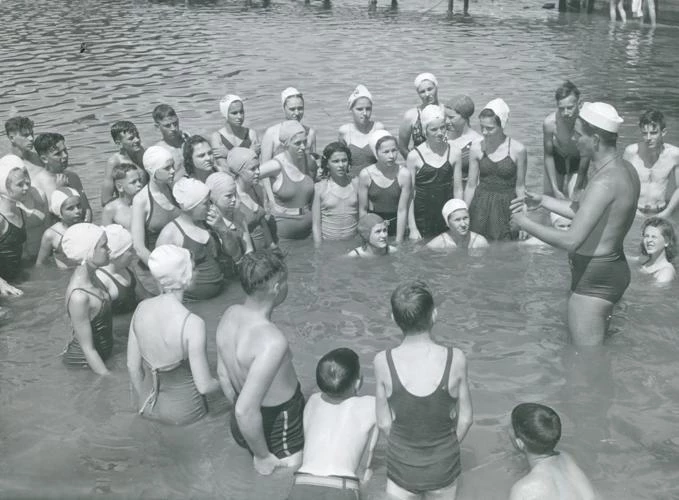The COVID-19 crisis has taken many things from us—above all, the lives of 125,000 Americans.
We have also lost, for a time, many of the simpler pleasures that enrich family, neighborhood and community—everything from potlucks to baseball games, and dance recitals to the corner tavern.
Also struggling to make a comeback is that idyllic summertime staple—summer camp, a world unto itself of swimming, sunburn, campfires, homesickness and, let’s not forget, friendships to last a lifetime.
Lake Bloomington was built in 1929-1930 by impounding a stretch of Money Creek, northeast of Hudson. The powers that be—with a nudge from civic-minded folk—agreed to set aside significant shoreline acreage for the enjoyment of public-spirited endeavors. From such foresight came the Boy Scouts’ Camp Heffernan (today the Easterseals Timber Pointe Outdoor Center); Camp Peairs, run by the Girls Scouts; and East Bay Camp.
It is to the last of these three camps that we turn our attention. Situated on the lake’s eastern shore, East Bay boasts some of the more picturesque and contemplative spots in all McLean County.
And what better place to discover the history of this wooded retreat than the McLean County Museum of History, the award-winning, not-for-profit institution occupying the old courthouse in downtown Bloomington.
The museum’s library includes about 16,000 books and periodicals, and the archives span 2,000 linear feet of family papers, church records, diaries, pre-Civil War newspapers, scrapbooks, business ledgers, maps, and a whole lot more.
Not surprisingly, in these collections one will find a range of items—including brochures and fliers, bulletins, a newsletter or two, many photographs, and even a one-of-a kind scrapbook compiled in 1934—that reach back in time to the origins and early years of East Bay Camp.
Research will show that although long associated with various Protestant denominations—Methodist, Baptist, Evangelical Reformed, Lutheran, Presbyterian, United Brethren, and others—East Bay has always welcomed, and sometimes partnered with, groups such as 4-H and Kiwanis.
The story of East Bay is inextricably tied to the story of the Rev. Frank L. Breen, who shepherded the camp through its establishment and rocky start. He then worked tirelessly to make it one of the premier youth and adult church camps in the Prairie State, remaining an invaluable force in its continued success until his death in 1967.
As a young man in his thirties, Breen came to Bloomington in 1920 to first serve as minister of the Congregational Church, and later Second Presbyterian (a move necessitated when the latter absorbed the former.)
He lived a life not cloistered among his congregants, but rather one dedicated to making his adopted hometown a better place to live. As such, he played an instrumental role getting the Western Avenue Community Center up and running in 1926, and then served as its full-time director from 1931 to 1956.
His first wife, Flora J. Giles, died in 1927, and eighteen years later he married Thelma Van Ness, the head librarian at Withers, Bloomington’s long-gone public library. A graduate of Illinois Wesleyan and the University of Illinois Library School, Breen led Withers from 1941 until retirement in 1972.
The history museum’s archives include the Frank Breen Collection, consisting mostly of personal and business papers. In addition to East Bay materials, this collection also contains correspondence involving Breen’s relief work during the Great Depression, and his efforts to promote new housing for World War II veterans.
One of the more informative East Bay items held by the museum is “A Walk with Mr. Breen,” a 12-page booklet published in 1963, in which Pantagraph reporter Tom Gumbrell strolls the camp grounds with the still-spry good reverenced, who by then was in his late 70s.
In this booklet, Breen recounts a 1929 meeting with Lester Martin, an attorney for a group of investors set to construct Lake Bloomington, a long-overdue project for a city then lacking a safe and reliable water supply. The two men drove out to the site of the future lake, and when the roads came to an end near Money Creek, they walked down into a steep hollow—which, once impounded, would be well underwater. It was there they talked about the lake and the dream of a summer camp.
Martin promised a leasehold if Breen could promise a viable camp. “So we shook hands on it both of us accepting that as a retainer I suppose—right down there in the bottom of East Bay,” Breen recounted. “And that was the beginning.”
Call is the handshake at the bottom of the bay!
By 1934—four years after the lake’s completion—the camp’s 40 or so original acres featured a half-mile-long shoreline and an “extensive hinterland of marsh, woods and prairie.” There were sleeping cabins, floored tents, a dining lodge, trading post, outdoor theater, boat docks and swimming beaches.
Interestingly, the camp was also once home to the Nellie E. Parham Library, a branch of Withers that catered to campers and local residents.
Ninety years after its establishment, East Bay Camp’s mission remains substantially the same—to be a welcoming retreat “set aside for children and adults alike to experience the wonder of God’s creation.”
Sadly, the ongoing pandemic has led to the cancellation of the 2020 camp season. Born in the depths of the Great Depression, East Bay has survived earlier national traumas, so there’s no reason to think it won’t survive this one.
Until then, the Rev. Frank Breen will leave us on a hopeful note: “You see things that need to be done, things that should be done,” he said of his beloved East Bay Camp. “And if they should be done, they can be done.”
Amen to that, Rev. Breen.

